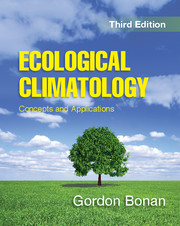Book contents
- Frontmatter
- Dedication
- Contents
- Preface
- 1 Ecosystems and Climate
- Part I The Earth System
- Part II Global Physical Climatology
- Part III Hydrometeorology
- Part IV Biometeorology
- Part V Terrestrial Plant Ecology
- 18 Plant Strategies
- 19 Populations and Communities
- 20 Ecosystems
- 21 Soil Biogeochemistry
- 22 Vegetation Dynamics
- 23 Landscapes and Disturbances
- 24 Global Biogeography
- Part VI Terrestrial Forcings and Feedbacks
- Appendix
- Index
- Plate section
- References
18 - Plant Strategies
from Part V - Terrestrial Plant Ecology
Published online by Cambridge University Press: 05 November 2015
- Frontmatter
- Dedication
- Contents
- Preface
- 1 Ecosystems and Climate
- Part I The Earth System
- Part II Global Physical Climatology
- Part III Hydrometeorology
- Part IV Biometeorology
- Part V Terrestrial Plant Ecology
- 18 Plant Strategies
- 19 Populations and Communities
- 20 Ecosystems
- 21 Soil Biogeochemistry
- 22 Vegetation Dynamics
- 23 Landscapes and Disturbances
- 24 Global Biogeography
- Part VI Terrestrial Forcings and Feedbacks
- Appendix
- Index
- Plate section
- References
Summary
Chapter Summary
A plant uses the carbon gained during photosynthesis for maintenance and survival, to grow foliage, a stem, and roots, and for reproduction. It must allocate its limited available resources among growth, maintenance, and reproduction in a manner such that the species persists over time. Plants exhibit different strategies for allocating resources, collectively known as life history patterns. A successful strategy is to invest heavily in reproductive effort. The plant is small, short lived, and has many widely dispersed seeds, such as a herbaceous annual. An equally successful strategy is to be large, long lived, and have a small crop of large seeds, such as a tree. This life history favors maintenance over reproduction. There are multiple life history patterns that allow success in a given environment, but not all are successful in all environments. The environment selectively determines which strategy is successful. These life histories ensure the persistence of multiple species across the landscape in accordance with resource gradients and disturbance regimes. They give pattern to the arrangement of plant populations and communities in space and time. Three conceptualizations of plant strategies are the classifications of species into: r- and K-selected life histories; ruderal, competitor, and stress tolerator plants; and early and late successional species. More generally, plant functional types are broad classes of plants that reduce the complexity of species diversity in ecological function to a few plant types defined by key physiological and life history characteristics. However, plant traits have a continuum of variation. These traits are understood in terms of functional tradeoffs between high metabolism and persistence.
Carbon Balance of Plants
The net carbon gain of a plant that is available for growth is the difference between carbon uptake during photosynthesis and carbon loss during respiration (Figure 18.1). The photosynthetic uptake of an individual leaf must be summed over all foliage held by the plant to give gross primary production (GPP). Respiration loss must be summed over all tissues in the plant. The combined whole-plant respiration is termed autotrophic respiration (RA) and is typically about 50 percent of gross primary production (Ryan 1991). Plant respiration is divided into growth respiration, which is independent of temperature, and maintenance respiration, which increases with higher temperatures. Growth respiration releases CO2 during the synthesis of new tissues. This involves the incorporation of carbon into organic compounds and the expenditure of metabolic energy to produce the compounds.
- Type
- Chapter
- Information
- Ecological ClimatologyConcepts and Applications, pp. 291 - 314Publisher: Cambridge University PressPrint publication year: 2015



